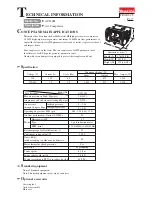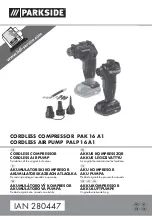
Instructions
© Danfoss | DCS (CC) | 2018.02 | 3
FRCC.PI.020.A2.02
• The compressor ambient temperature may not
exceed 55°C during off-cycle.
• Mount the compressor on a horizontal flat sur-
face with less than 3° slope.
• Verify that the power supply corresponds to the com-
pressor motor characteristics (see nameplate).
• When installing PSH, use equipment specifi-
cally reserved for HFC refrigerants which was
never used for CFC or HCFC refrigerants.
• Use clean and dehydrated refrigeration-grade
copper tubes and silver alloy brazing material.
• Use clean and dehydrated system components.
• The piping connected to the compressor must be
flexible in 3 dimensions to dampen vibrations.
4 – Assembly
• In parallel assemblies of PSH the compressor
requires a rigid mounting on the rails. Use the
pre-mounted rigid spacers.
• Slowly release the nitrogen holding charge
through the schrader port.
• Connect the compressor to the system as soon
as possible to avoid oil contamination from
ambient moisture.
• Avoid material entering into the system while
cutting tubes. Never drill holes where burrs
cannot be removed.
• Braze with great care using state-of-the-art tech-
nique and vent piping with nitrogen gas flow.
• Connect the required safety and control de-
vices. When the schrader port is used for this,
remove the internal valve.
• The liquid injection valve must be fed by liquid,
picked-up on the liquid line of the system,
downstream the filter drier.
• Protect the compressor and the liquid injection
valve against heat while brazing the liquid line.
5 – Leak detection
Never pressurize the circuit with oxygen or
dry air. This could cause fire or explosion.
• Pressurize the system on HP side first and then
on LP side. Never let the pressure on LP side ex-
ceed the pressure on HP side with more than 5
bar. Such pressure difference could cause internal
compressor damage.
• Do not use dye for leak detection.
• Perform a leak detection test on the complete
system.
• The test pressure must not exceed :
Models
LP side HP side
PSH 019.023.026.030.034.039
33.3bar 48.7bar
• When a leak is discovered, repair the leak and
repeat the leak detection.
6 – Vacuum dehydration
• Never use the compressor to evacuate the sys-
tem.
• Connect a vacuum pump to both the LP & HP
sides.
• Pull down the system under a vacuum of 500
µm Hg (0.67 mbar) absolute.
• Do not use a megohmmeter nor apply power
to the compressor while it is under vacuum as
this may cause internal damage.
7 – Electrical connections
• Switch off and isolate the main power supply.
• All electrical components must be selected as per
local standards and compressor requirements.
• The Danfoss scroll compressor only works cor-
rectly in one rotation direction. Line phases L1,
L2, L3 must absolutely be connected to com-
pressor terminals T1, T2, T3 to avoid reverse ro-
tation.
• Use ø 4.8 mm (3/16”) screws and ¼” ring termi-
nals for the power connection. Fasten with 3
Nm torque.
• The compressor must be connected to earth
with the 5 mm earth terminal screw.
•
Connect the discharge temperature sensor
cable plug to OCS.
• Connect the OCS to power supply and earth
To avoid personal injury, with 230V OCS, do
not forget to connect the earth, and to check for
earth continuity.
PSH019-023-026-030-034-039’s OCS inte-
grated phase protection/DGT protection func-
tion. Never disconnect the pre-installed wire
between terminal pins and OCS. And make sure
the OCS relay output is connected to system
control safety chain.
8 – Filling the system
• Keep the compressor switched off.
•
Fill the refrigerant in liquid phase into the
condenser or liquid receiver. The charge must
be as close as possible to the nominal system
charge to avoid low pressure operation and ex-
cessive superheat. Never let the pressure on LP
side exceed the pressure on HP side with more
than 5 bar. Such pressure difference could cause
internal compressor damage.
• Keep the refrigerant charge below the indi-
cated charge limits if possible. Above this limit;
protect the compressor against liquid flood-
back with a pump-down cycle or suction line
accumulator.
• Never leave the filling cylinder connected to
the circuit.
Compressor models
Refrigerant
charge limit (kg)
PSH019
5.9
PSH023.026.030.034.039
7.9
9 – Verification before commissioning
Use safety devices such as safety pressure
switch and mechanical relief valve in compliance
with both generally and locally applicable regu-
lations and safety standards. Ensure that they
are operational and properly set.
Check that the settings of high-pressure swit-
ches and relief valves don’t exceed the maximum
service pressure of any system component.
•
A low-pressure switch is recommended to
avoid vacuum operation. Minimum setting for
PSH: 1.6 bar (absolute).
• Verify that all electrical connections are proper-
ly fastened and in compliance with local regu-
lations.
• Ensure that the liquid injection valve (LIV) coil
is correctly positioned on the LIV body: one of
the lock pins on the coil must fit into one of the
dents on the valve body.
• When a crankcase heater is required, it must be
energized at least 12 hours before initial start-
up and start-up after prolonged shutdown for
belt type crankcase heaters (6 hours for surface
sump heaters).
10 – Start-up
• Never start the compressor when no refrige-
rant is charged.
• All service valves must be in the open position.
• Balance the HP/LP pressure.
• Energize the compressor. It must start promp-
tly. If the compressor does not start, check wi-
ring conformity and voltage on terminals.
• If the internal overload protector trips out, it
must cool down to 60°C to reset. Depending
on ambient temperature, this may take up to
several hours.
11 – Check with running compressor
• Check current draw and voltage.
• Check suction superheat to reduce risk of slug-
ging.
• Observe the oil level in the sight glass for about
60 minutes to ensure proper oil return to the
compressor.
• Check all tubes for abnormal vibration. Move-
ments in excess of 1.5 mm require corrective
measures such as tube brackets.
• When needed, additional refrigerant in liquid
phase may be added in the low-pressure side as
far as possible from the compressor. The com-
pressor must be operating during this process.
• Do not overcharge the system.
• Never release refrigerant to atmosphere.
• Before leaving the installation site, carry out
a general installation inspection regarding
cleanliness, noise and leak detection.
• Record type and amount of refrigerant charge
as well as operating conditions as a reference
for future inspections.
12 – Maintenance
Internal pressure and surface temperature
are dangerous and may cause permanent inju-
ry.Maintenance operators and installers require
appropriate skills and tools. Tubing temperature
may exceed 100°C and can cause severe burns.
Ensure that periodic service inspections to
ensure system reliability and as required by local
regulations are performed.
To prevent system related compressor problems,
following periodic maintenance is recommended:




































